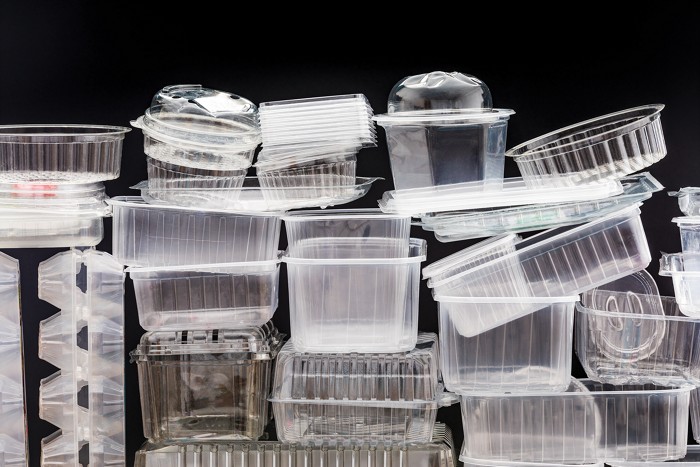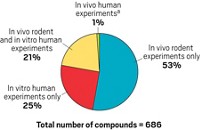Advertisement
Grab your lab coat. Let's get started
Welcome!
Welcome!
Create an account below to get 6 C&EN articles per month, receive newsletters and more - all free.
It seems this is your first time logging in online. Please enter the following information to continue.
As an ACS member you automatically get access to this site. All we need is few more details to create your reading experience.
Not you? Sign in with a different account.
Not you? Sign in with a different account.
ERROR 1
ERROR 1
ERROR 2
ERROR 2
ERROR 2
ERROR 2
ERROR 2
Password and Confirm password must match.
If you have an ACS member number, please enter it here so we can link this account to your membership. (optional)
ERROR 2
ACS values your privacy. By submitting your information, you are gaining access to C&EN and subscribing to our weekly newsletter. We use the information you provide to make your reading experience better, and we will never sell your data to third party members.
Consumer Products
Plastic food packaging contains thousands of chemicals, study finds
Chemicals extracted from consumer products in 5 countries interacted with endocrine and metabolic systems in cell-based lab tests
by Katherine Bourzac, special to C&EN
March 19, 2024

Food packaging from five countries has complex, unique chemical fingerprints, and some items contain thousands of different chemicals, according to a new study (Environ. Sci. Technol. 2024, DOI: 10.1021/acs.est.3c08250). A single piece of cling film from the UK had about 9,000 different chemicals in it. Lab-based screening showed that extracts from most of these real-world products activated or inhibited cell receptors that regulate the endocrine and metabolic systems.
“Plastic products we’re using every day contain many unknown chemicals,” says Martin Wagner, a biologist who studies plastics at the Norwegian University of Science and Technology(NTNU) in Gløshaugen and coauthored the work. “This is a major problem for scientists, policymakers, and even for producers,” he says. Wagner and his collaborators wanted to fill in some of this unknown landscape by finding out what those chemicals might be and whether they should be examined for health effects.
The NTNU researchers asked colleagues and friends in the US, the UK, South Korea, and Germany to go to supermarkets to get plastic packaging for them; the team bought some locally in Norway as well. The study focused on 36 plastic items that came directly into contact with food and beverages, including cling film, milk bottles, sausage packaging, and hydration bladders like those used by hikers. Samples spanned the seven most commonly used polymer types.
The researchers used pure methanol to extract chemicals from each sample. Key to the study, they analyzed the extracts with nontargeted mass spectrometry (MS)—a powerful method that can detect a broad range of known and unknown chemicals in a sample. Christopher Reddy, a geochemist who specializes in plastic pollution at the Woods Hole Oceanographic Institution and was not involved in the study, says most of what we know about plastic chemicals comes from targeted screenings, which focus on finding specific, known molecules. “But that leaves a whole population of chemicals outside the analytical window.” The NTNU study pulls the curtain back to look for more, he says.
This wide-ranging approach found 16,846 unique chemical features—distinctive peaks in the MS data. Wagner says most of these likely correspond to particular chemicals, while a smaller number correspond to features within specific chemicals.
One food container had just 37 features; a piece of polyvinyl chloride cling film had 9,936. Wagner estimates that this corresponds to about 9,000 chemicals.
Reddy says the high numbers of chemical features might be explained by isomers in the mix. These structurally different versions of chemicals may or may not have different toxicities—it’s simply impossible for the researchers behind the study to know, he says. “They can’t constrain the chemical structures or the sources. It doesn’t provide absolute clarity.”
Wagner says some of these chemicals are intentional additives, like plasticizers and stabilizers. Other chemicals in plastics can be formed by side reactions, impurities in the starting ingredients, or the degradation of a plastic container over time.
The NTNU scientists also assessed whether the plastic extracts interacted with four important cell receptors. They tested for interactions with estrogen and androgen receptors—key players in the endocrine system—and receptors involved in metabolic regulation. Extracts from plastics of all the polymer types in the study activated or inhibited one or more of these receptors.
Advertisement
In another study published at the same time, Wagner’s group screened plastic extracts and additives to see if they bind to and potentially disrupt more than 100 G protein–coupled receptors (GPCRs). These proteins are found on cell surfaces and play a key role in cell signaling and physiology. The team found that several samples strongly interacted with two GPCRs that may be linked to circadian and metabolic processes (Environ. Sci. Technol. 2024, DOI: 10.1021/acs.est.3c08392).
This is the first time plastic chemicals have been found to interact with GPCRs. These proteins have been intensely studied by the pharmaceutical industry but not by toxicologists, Wagner says. “It’s really time to look at all kinds of other signaling receptors” and how they interact with plastic chemicals, he says.
Wagner says there is some good news in all these data. Extracts from plastic food packaging containing fewer chemicals had less biological activity, which indicates that it’s possible to make plastics that are functional but carry lower potential risk.
Reddy calls this kind of work “the beginning of a field” and a compelling case for more research to identify and assess the concentrations of these chemicals and to find out which ones have biological effects.





Join the conversation
Contact the reporter
Submit a Letter to the Editor for publication
Engage with us on Twitter